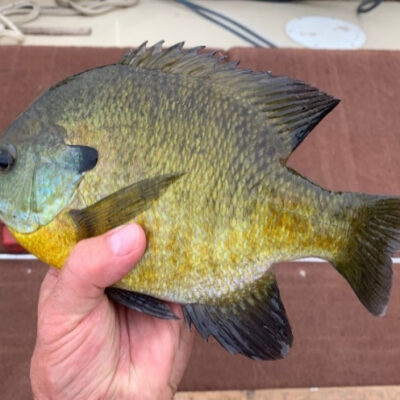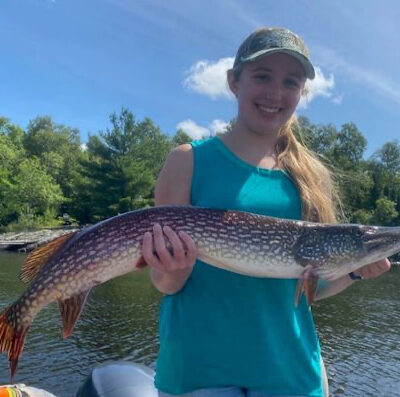Catch and Release Trophy Panfish
Here are two 10 year old fish – which one is more likely to be eaten?
Some years ago, InFisherman magazine began emphasizing the common-sense of selective harvest of mid-size panfish, and recognition of large panfish as respectable trophies worthy of release, and not just as food. “Keep enough for a meal”, they would say. The name “panfish” I guess is unfortunate, because it kind of defines the predetermined destiny of this broad class of fish. They’re “eaters”! What fisherman didn’t grow up defining success as a bucket or basket heavy with panfish headed for release into the grease? I am guilty as charged. Fifty years ago, I would catch gills on Vermilion too large to get your hand around, like dessert plates, and over 30 years ago proudly caught stringers of 10” bluegills with my kids, but guess what? They’re almost gone. We ate them all.
A classic 1989 study by Olson and Cunningham graphically documented the historical decline of bluegills around Park Rapids MN, where records of local “trophy fish” from the Fuller’s Hardware Fishing Contest from 1930 to 1987 showed that until 1953 the average size of contest-entered bluegills was 1.3 lbs (and black crappies were over 1.75 lbs), but gradually declining until in 1987 largest bluegill entries were only about 0.75 lbs, and crappies at 1.25 lbs.
Let’s look at what we do. We sit on a spawning bed and pick off the most aggressive (and vulnerable) large male bluegills – the genetic future of our lake. You recall that males have more vibrant colors, often a coppery orange breast, and females are silver and green. Understand that there are two types of male bluegills – the big dominant ones that take 7-8 years to mature, that are most successful at defending nests and preventing depredation of their fry, and then smaller “sneaker” or “cuckolder” males that mature in 4-5 years, never get big, and find ways to pass on their genes by being, well, sneaky. They will try to spawn alongside the dominant males, even assuming a female’s coloration to fool the larger males into allowing them into the nest to share in fertilizing eggs.
Crazy stuff, but then so is what WE do! We yank those big males off their nests and release the sneakers to take their place and pass on their inferior genes. If we find a pocket of big ones, we’ll clean them out. Maybe time for a rethink? A 2005 paper from the MN DNR showed improvement in bluegill size within 5 years after introducing a reduced bag limit on several lakes. And a 2015 paper presented by the WI DNR to The American Fisheries Society suggested reduced bag limits can be a useful tool in improving bluegill size.
What’s to be done? Well, let’s recognize that a bluegill over 8” is big for our lake, and a real 10-incher is a rarity, a surviving Methuselah that deserves respect and consideration for a reprieve. Keep those 7” males, and even bigger females, as there is evidence that releasing male bluegills over 8” is the right thing to do. The picture above is of the last honest 10” gill I caught here 2 years ago while flyfishing – I hope he’s still swimming.
My personal plan is to keep eating those tasty bluegills and fillet up the smaller ones with my electric fillet knife, which makes short work of them. Maybe I’ll scale and panfry some of them whole and headless, the old-fashioned way, munching on those crunchy fins (try it!). I’ll eat more of the females – that surprisingly does not impact the population as much. But I will limit my overall kill and show the big boys over 8”-9” some respect and let them go. There is sense to this approach for bluegills; not as many studies have focused on MN perch and crappies, but it seems intuitively right to consider releasing unusually large perch (over 12”) and crappies over 13”.
Maybe if we all show our panfish a little respect, admire them and watch those larger panfish swim away, we can bring back some of those good old days!
Read eVermilion


